
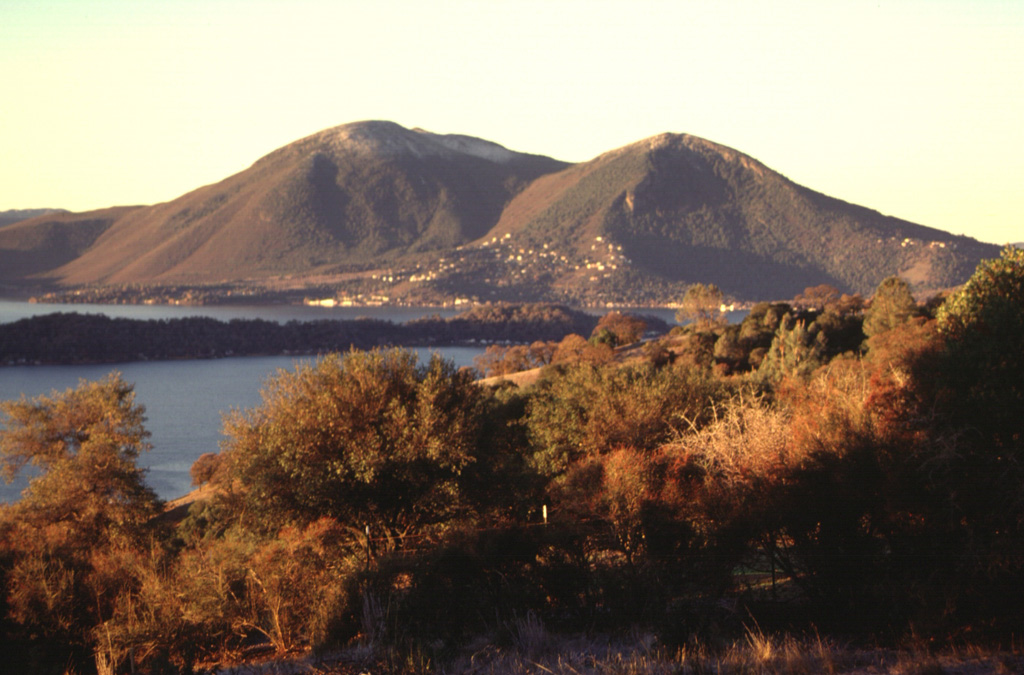
50 small seismic events triggered by M 7.5 earthquake hundreds of km away
Southern California's largest earthquake since 1952, M 7.5 on 28 June, appeared to trigger seismicity at several volcanic centers in California. It was centered roughly 200 km E of Los Angeles. In the following, David Hill describes post-earthquake activity at Long Valley caldera, and Stephen Walter discusses the USGS's seismic network, and the changes it detected at Lassen, Shasta, Medicine Lake, and the Geysers.
In recent years, the USGS northern California seismic network has relied upon Real-Time Processors (RTPs) to detect, record, and locate earthquakes. However, a film recorder (develocorder) collects data from 18 stations in volcanic areas, primarily to detect long-period earthquakes missed by RTPs. The film recorders proved useful in counting the post-M 7.5 earthquakes, most of which were too small to trigger the RTPs.
The film record was scanned for the 24 hours after the M 7.5 earthquake, noting the average coda duration for each identified event. Some events may have been missed because of seismogram saturation by the M 7.5 earthquake. Marked increases in microseismicity were observed at Lassen Peak, Medicine Lake caldera, and the Geysers (table 1). No earthquakes were observed at Shasta, but the lack of operating stations on the volcano limited the capability to observe small events.
Table 1. Number of earthquakes at northern California volcanic centers during 24-hour periods following major earthquakes on 25 April (40.37°N, 124.32°W; M 7.0) and 28 June (34.18°N, 116.47°W; M 7.5) 1992. Events with coda durations less than or equal to 10 seconds and greater than 10 seconds are tallied separately. Earthquakes were identified from film records of seismograms from nearby stations. Courtesy of Stephen Walter.
| Volcanic center | Lassen | Lassen | Shasta | Shasta | Medicine Lake | Medicine Lake | Geysers | Geysers |
| Codas (seconds) | 0-10 | 11+ | 0-10 | 11+ | 0-10 | 11+ | 0-10 | 11+ |
| 25 Apr 1992 | 0 | 0 | 0 | 1 | 0 | 0 | 7 | 2 |
| 28 Jun 1992 | 8 | 14 | 1 | 5 | 12 | 0 | 46 | 4 |
Film was also scanned for the 24 hours following the M 7.0 earthquake at 40.37°N, 124.32°W (near Cape Mendocino) on 25 April. Although smaller than the 28 June earthquake, its epicenter was only 20-25% as far from the volcanoes. Furthermore, both the 25 April main shock and a M 6.5 aftershock were felt at the volcanic centers, but no felt reports were received from these areas after the 28 June earthquake. Only the Geysers showed any possible triggered events after the 25 April shock. However, background seismicity at the Geysers is higher than at the other centers, and is influenced by fluid injection and withdrawal associated with intensive geothermal development.
Geysers geothermal area report. Film records showed 50 small events in the 24 hours following the M 7.5 earthquake, 46 of which had coda durations
Information Contacts: Stephen Walter and David Hill, MS 977, U.S. Geological Survey, 345 Middlefield Road, Menlo Park, California 94025 USA.
The Global Volcanism Program has no Weekly Reports available for Clear Lake Volcanic Field.
Reports are organized chronologically and indexed below by Month/Year (Publication Volume:Number), and include a one-line summary. Click on the index link or scroll down to read the reports.
50 small seismic events triggered by M 7.5 earthquake hundreds of km away
Southern California's largest earthquake since 1952, M 7.5 on 28 June, appeared to trigger seismicity at several volcanic centers in California. It was centered roughly 200 km E of Los Angeles. In the following, David Hill describes post-earthquake activity at Long Valley caldera, and Stephen Walter discusses the USGS's seismic network, and the changes it detected at Lassen, Shasta, Medicine Lake, and the Geysers.
In recent years, the USGS northern California seismic network has relied upon Real-Time Processors (RTPs) to detect, record, and locate earthquakes. However, a film recorder (develocorder) collects data from 18 stations in volcanic areas, primarily to detect long-period earthquakes missed by RTPs. The film recorders proved useful in counting the post-M 7.5 earthquakes, most of which were too small to trigger the RTPs.
The film record was scanned for the 24 hours after the M 7.5 earthquake, noting the average coda duration for each identified event. Some events may have been missed because of seismogram saturation by the M 7.5 earthquake. Marked increases in microseismicity were observed at Lassen Peak, Medicine Lake caldera, and the Geysers (table 1). No earthquakes were observed at Shasta, but the lack of operating stations on the volcano limited the capability to observe small events.
Table 1. Number of earthquakes at northern California volcanic centers during 24-hour periods following major earthquakes on 25 April (40.37°N, 124.32°W; M 7.0) and 28 June (34.18°N, 116.47°W; M 7.5) 1992. Events with coda durations less than or equal to 10 seconds and greater than 10 seconds are tallied separately. Earthquakes were identified from film records of seismograms from nearby stations. Courtesy of Stephen Walter.
| Volcanic center | Lassen | Lassen | Shasta | Shasta | Medicine Lake | Medicine Lake | Geysers | Geysers |
| Codas (seconds) | 0-10 | 11+ | 0-10 | 11+ | 0-10 | 11+ | 0-10 | 11+ |
| 25 Apr 1992 | 0 | 0 | 0 | 1 | 0 | 0 | 7 | 2 |
| 28 Jun 1992 | 8 | 14 | 1 | 5 | 12 | 0 | 46 | 4 |
Film was also scanned for the 24 hours following the M 7.0 earthquake at 40.37°N, 124.32°W (near Cape Mendocino) on 25 April. Although smaller than the 28 June earthquake, its epicenter was only 20-25% as far from the volcanoes. Furthermore, both the 25 April main shock and a M 6.5 aftershock were felt at the volcanic centers, but no felt reports were received from these areas after the 28 June earthquake. Only the Geysers showed any possible triggered events after the 25 April shock. However, background seismicity at the Geysers is higher than at the other centers, and is influenced by fluid injection and withdrawal associated with intensive geothermal development.
Geysers geothermal area report. Film records showed 50 small events in the 24 hours following the M 7.5 earthquake, 46 of which had coda durations
Information Contacts: Stephen Walter and David Hill, MS 977, U.S. Geological Survey, 345 Middlefield Road, Menlo Park, California 94025 USA.
This compilation of synonyms and subsidiary features may not be comprehensive. Features are organized into four major categories: Cones, Craters, Domes, and Thermal Features. Synonyms of features appear indented below the primary name. In some cases additional feature type, elevation, or location details are provided.
Cones |
||||
| Feature Name | Feature Type | Elevation | Latitude | Longitude |
| Cobb Mountain | Cone | 1439 m | 38° 49' 0" N | 122° 44' 0" W |
| Round Mountain | Cone | 39° 3' 0" N | 122° 38' 0" W | |
| Roundtop Mountain | Cone | 38° 55' 0" N | 122° 40' 0" W | |
Domes |
||||
| Feature Name | Feature Type | Elevation | Latitude | Longitude |
| Hannah, Mount | Dome | 1212 m | 38° 53' 0" N | 122° 45' 0" W |
| Konocti, Mount | Dome | 38° 59' 0" N | 122° 46' 0" W | |
Thermal |
||||
| Feature Name | Feature Type | Elevation | Latitude | Longitude |
| Geysers, The | Geyser | 38° 48' 0" N | 122° 48' 0" W | |
|
|
||||||||||||||||||||||||
The Global Volcanism Program is not aware of any Holocene eruptions from Clear Lake Volcanic Field. If this volcano has had large eruptions (VEI >= 4) prior to 10,000 years ago, information might be found on the Clear Lake Volcanic Field page in the LaMEVE (Large Magnitude Explosive Volcanic Eruptions) database, a part of the Volcano Global Risk Identification and Analysis Project (VOGRIPA).
There is no Deformation History data available for Clear Lake Volcanic Field.
There is no Emissions History data available for Clear Lake Volcanic Field.
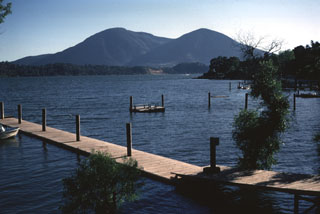 Mount Konocti, a twin-peaked complex dacitic volcano of Pleistocene age on the south-central shore of Clear Lake, is the most prominent feature of the Clear Lake volcanic field. Wright Peak (left) is a rhyodacitic and dacitic lava dome with associated lava flows, and Buckingham Peak (right) is composed of dacitic lava flows capped by an eroded basaltic-andesite cinder cone. The flat ridge extending across the photo in front of Mount Konocti is a peninsula of Cretaceous-Jurrasic rocks of the Franciscan formation.
Mount Konocti, a twin-peaked complex dacitic volcano of Pleistocene age on the south-central shore of Clear Lake, is the most prominent feature of the Clear Lake volcanic field. Wright Peak (left) is a rhyodacitic and dacitic lava dome with associated lava flows, and Buckingham Peak (right) is composed of dacitic lava flows capped by an eroded basaltic-andesite cinder cone. The flat ridge extending across the photo in front of Mount Konocti is a peninsula of Cretaceous-Jurrasic rocks of the Franciscan formation. Mount Konocti, seen here beyond the southern shore of Clear Lake, is the largest feature of the Clear Lake volcanic field in the northern California Coast Ranges. The volcanic field contains lava dome complexes, scoria cones, and maars. It is located far to the west of the Cascade Range.
Mount Konocti, seen here beyond the southern shore of Clear Lake, is the largest feature of the Clear Lake volcanic field in the northern California Coast Ranges. The volcanic field contains lava dome complexes, scoria cones, and maars. It is located far to the west of the Cascade Range.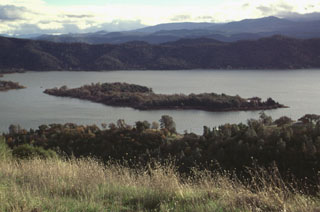 Elongated Rattlesnake Island near the NE tip of Clear Lake is seen here from the NW. Most of the flat-lying western side of the island is a basaltic-andesite lava flow of late-Pleistocene age. The flow was erupted to the NE and NW from a cinder cone that is the gently rounded ridge that forms the far southern tip of the island at the left. The scoriaceous aa flow was erupted subaerially above the lake level.
Elongated Rattlesnake Island near the NE tip of Clear Lake is seen here from the NW. Most of the flat-lying western side of the island is a basaltic-andesite lava flow of late-Pleistocene age. The flow was erupted to the NE and NW from a cinder cone that is the gently rounded ridge that forms the far southern tip of the island at the left. The scoriaceous aa flow was erupted subaerially above the lake level.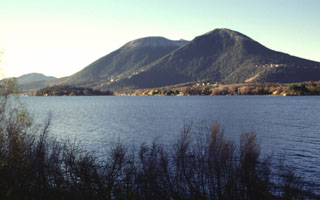 Mount Konocti, a composite dacitic volcano, rises above the southern shore of Clear Lake. The arcuate escarpment facing the lake on the the NW-most peak, Buckingham Peak (right), is a landslide scarp produced when part of the dome collapsed. A series of maars cuts the southern shore of Clear Lake, giving it a scalloped shoreline. Clear Lake itself, the largest natural freshwater lake entirely within California, is an elongated, irregular body of water more than 30 km long. It has a volcano-tectonic origin.
Mount Konocti, a composite dacitic volcano, rises above the southern shore of Clear Lake. The arcuate escarpment facing the lake on the the NW-most peak, Buckingham Peak (right), is a landslide scarp produced when part of the dome collapsed. A series of maars cuts the southern shore of Clear Lake, giving it a scalloped shoreline. Clear Lake itself, the largest natural freshwater lake entirely within California, is an elongated, irregular body of water more than 30 km long. It has a volcano-tectonic origin.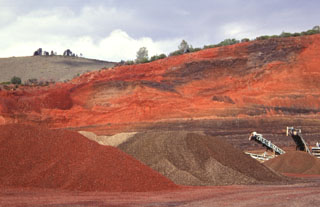 Brilliantly colored, bright-red oxidized scoria deposits from a cinder cone near the SE end of Clear Lake are quarried for road aggregate. The basaltic-andesite cinder cone is one of a N-S-trending chain of young cones at the eastern margin of the Clear Lake volcanic field. This the northernmost of two quarried cinder cones bissected by the highway leading into the town of Clearlake Oaks.
Brilliantly colored, bright-red oxidized scoria deposits from a cinder cone near the SE end of Clear Lake are quarried for road aggregate. The basaltic-andesite cinder cone is one of a N-S-trending chain of young cones at the eastern margin of the Clear Lake volcanic field. This the northernmost of two quarried cinder cones bissected by the highway leading into the town of Clearlake Oaks.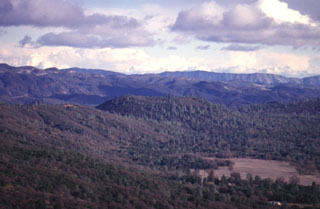 Round Mountain (center), seen here from the WNW with the hills of the California Coast Range in the background, is one of a series of basaltic-andesite cinder cones erupted along a N-S-trending line at the eastern margin of the Clear Lake volcanic field. These cones form some of the youngest products of the volcanic field. Lava flows from Round Mountain extend west into High Valley (lower right) and east to the North Fork Cache River. The background hills are composed of Cretaceous-Jurrasic metamorphic rocks of the Franciscan formation.
Round Mountain (center), seen here from the WNW with the hills of the California Coast Range in the background, is one of a series of basaltic-andesite cinder cones erupted along a N-S-trending line at the eastern margin of the Clear Lake volcanic field. These cones form some of the youngest products of the volcanic field. Lava flows from Round Mountain extend west into High Valley (lower right) and east to the North Fork Cache River. The background hills are composed of Cretaceous-Jurrasic metamorphic rocks of the Franciscan formation.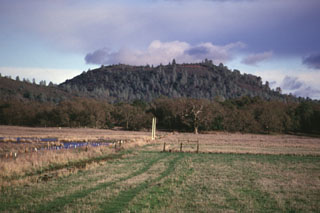 Round Mountain, seen here from the west, rises above the floor of High Valley. Round Mountain is the northernmost of a N-S-trending chain of basaltic-andesite cinder cones at the eastern end of the Clear Lake volcanic field. A lava flow from Round Mountain underlies part of the High Valley. Many of the basaltic-andesite and andesitic lava flows of the Clear Lake field are contaminated with crustal materials. They often contain xenocrysts of quartz up to several cm in size that are known locally as "Lake County Diamonds."
Round Mountain, seen here from the west, rises above the floor of High Valley. Round Mountain is the northernmost of a N-S-trending chain of basaltic-andesite cinder cones at the eastern end of the Clear Lake volcanic field. A lava flow from Round Mountain underlies part of the High Valley. Many of the basaltic-andesite and andesitic lava flows of the Clear Lake field are contaminated with crustal materials. They often contain xenocrysts of quartz up to several cm in size that are known locally as "Lake County Diamonds."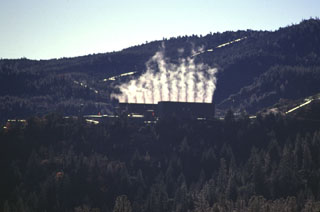 The Geysers steam field is located at the SW end of the Clear Lake volcanic field in the Coast Ranges of western California. A large silicic magma reservoir provides the heat source.
The Geysers steam field is located at the SW end of the Clear Lake volcanic field in the Coast Ranges of western California. A large silicic magma reservoir provides the heat source.The maps shown below have been scanned from the GVP map archives and include the volcano on this page. Clicking on the small images will load the full 300 dpi map. Very small-scale maps (such as world maps) are not included. The maps database originated over 30 years ago, but was only recently updated and connected to our main database. We welcome users to tell us if they see incorrect information or other problems with the maps; please use the Contact GVP link at the bottom of the page to send us email.
There are no samples for Clear Lake Volcanic Field in the Smithsonian's NMNH Department of Mineral Sciences Rock and Ore collection.
| Copernicus Browser | The Copernicus Browser replaced the Sentinel Hub Playground browser in 2023, to provide access to Earth observation archives from the Copernicus Data Space Ecosystem, the main distribution platform for data from the EU Copernicus missions. |
| MIROVA | Middle InfraRed Observation of Volcanic Activity (MIROVA) is a near real time volcanic hot-spot detection system based on the analysis of MODIS (Moderate Resolution Imaging Spectroradiometer) data. In particular, MIROVA uses the Middle InfraRed Radiation (MIR), measured over target volcanoes, in order to detect, locate and measure the heat radiation sourced from volcanic activity. |
| MODVOLC Thermal Alerts | Using infrared satellite Moderate Resolution Imaging Spectroradiometer (MODIS) data, scientists at the Hawai'i Institute of Geophysics and Planetology, University of Hawai'i, developed an automated system called MODVOLC to map thermal hot-spots in near real time. For each MODIS image, the algorithm automatically scans each 1 km pixel within it to check for high-temperature hot-spots. When one is found the date, time, location, and intensity are recorded. MODIS looks at every square km of the Earth every 48 hours, once during the day and once during the night, and the presence of two MODIS sensors in space allows at least four hot-spot observations every two days. Each day updated global maps are compiled to display the locations of all hot spots detected in the previous 24 hours. There is a drop-down list with volcano names which allow users to 'zoom-in' and examine the distribution of hot-spots at a variety of spatial scales. |
|
WOVOdat
Single Volcano View Temporal Evolution of Unrest Side by Side Volcanoes |
WOVOdat is a database of volcanic unrest; instrumentally and visually recorded changes in seismicity, ground deformation, gas emission, and other parameters from their normal baselines. It is sponsored by the World Organization of Volcano Observatories (WOVO) and presently hosted at the Earth Observatory of Singapore.
GVMID Data on Volcano Monitoring Infrastructure The Global Volcano Monitoring Infrastructure Database GVMID, is aimed at documenting and improving capabilities of volcano monitoring from the ground and space. GVMID should provide a snapshot and baseline view of the techniques and instrumentation that are in place at various volcanoes, which can be use by volcano observatories as reference to setup new monitoring system or improving networks at a specific volcano. These data will allow identification of what monitoring gaps exist, which can be then targeted by remote sensing infrastructure and future instrument deployments. |
| Volcanic Hazard Maps | The IAVCEI Commission on Volcanic Hazards and Risk has a Volcanic Hazard Maps database designed to serve as a resource for hazard mappers (or other interested parties) to explore how common issues in hazard map development have been addressed at different volcanoes, in different countries, for different hazards, and for different intended audiences. In addition to the comprehensive, searchable Volcanic Hazard Maps Database, this website contains information about diversity of volcanic hazard maps, illustrated using examples from the database. This site is for educational purposes related to volcanic hazard maps. Hazard maps found on this website should not be used for emergency purposes. For the most recent, official hazard map for a particular volcano, please seek out the proper institutional authorities on the matter. |
| IRIS seismic stations/networks | Incorporated Research Institutions for Seismology (IRIS) Data Services map showing the location of seismic stations from all available networks (permanent or temporary) within a radius of 0.18° (about 20 km at mid-latitudes) from the given location of Clear Lake Volcanic Field. Users can customize a variety of filters and options in the left panel. Note that if there are no stations are known the map will default to show the entire world with a "No data matched request" error notice. |
| UNAVCO GPS/GNSS stations | Geodetic Data Services map from UNAVCO showing the location of GPS/GNSS stations from all available networks (permanent or temporary) within a radius of 20 km from the given location of Clear Lake Volcanic Field. Users can customize the data search based on station or network names, location, and time window. Requires Adobe Flash Player. |
| DECADE Data | The DECADE portal, still in the developmental stage, serves as an example of the proposed interoperability between The Smithsonian Institution's Global Volcanism Program, the Mapping Gas Emissions (MaGa) Database, and the EarthChem Geochemical Portal. The Deep Earth Carbon Degassing (DECADE) initiative seeks to use new and established technologies to determine accurate global fluxes of volcanic CO2 to the atmosphere, but installing CO2 monitoring networks on 20 of the world's 150 most actively degassing volcanoes. The group uses related laboratory-based studies (direct gas sampling and analysis, melt inclusions) to provide new data for direct degassing of deep earth carbon to the atmosphere. |
| Large Eruptions of Clear Lake Volcanic Field | Information about large Quaternary eruptions (VEI >= 4) is cataloged in the Large Magnitude Explosive Volcanic Eruptions (LaMEVE) database of the Volcano Global Risk Identification and Analysis Project (VOGRIPA). |
| EarthChem | EarthChem develops and maintains databases, software, and services that support the preservation, discovery, access and analysis of geochemical data, and facilitate their integration with the broad array of other available earth science parameters. EarthChem is operated by a joint team of disciplinary scientists, data scientists, data managers and information technology developers who are part of the NSF-funded data facility Integrated Earth Data Applications (IEDA). IEDA is a collaborative effort of EarthChem and the Marine Geoscience Data System (MGDS). |